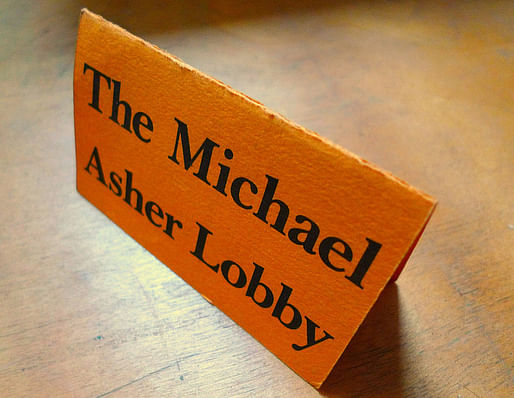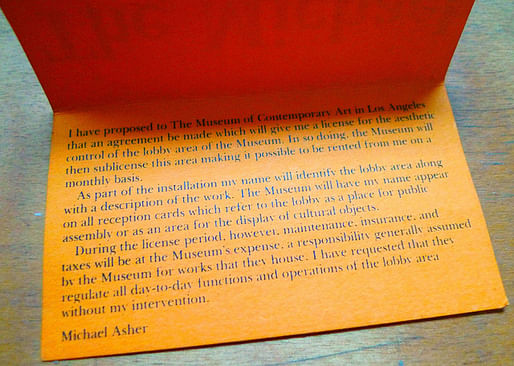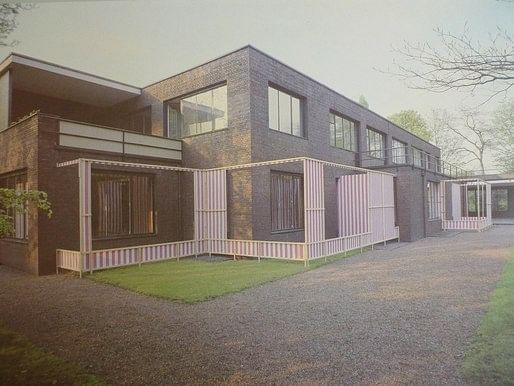
 Haus Lange installation, Michael Asher, 1982 (photo from the exhibition catalog)
Haus Lange installation, Michael Asher, 1982 (photo from the exhibition catalog)
LEARNING FROM MICHAEL ASHER
Michael Asher died almost two years ago in October 2012. When he was alive his work was mostly unknown to architects except somebody like Frank Gehry who was his good friend. In the art world, he was a hero and mentor to many art students with highly creative, fully engaging works and intensely figured out in-situ art installations. His teaching at Cal Arts was legendary. As an architecture student, I was introduced to his work by his lifelong friend and fellow artist John Knight, whom I studied under at SCI Arc from 1979 to 1981.
As Duchamp did with his readymades, Michael Asher also sought to connect art with people. In Asher's case they were decidedly more direct interdependencies between art and architecture.
What made Michael Asher extremely relevant to architecture has to do with his work in its spatial concerns and their contextual narratives, particularly site specific and situationist manipulations of space often in a dialog with the viewer via the sculptural platforms.
“Appearing/Disappearing Image/Object”
His “air works” is a good example of one of these sculptural platforms when Asher, inspired by the air movement inside a structure, installed a fan or combination of fans blowing air from the ceiling to floor in a conical spread, defining a territory in which a resultant interiority is felt by body's sensory reception of the moving air. Often using an industrial Dayton air blower as art material, Asher in one of his first installations experimented with the “air works” in appropriately titled exhibition called “Appearing/Disappearing Image/Object” in Newport Harbor Museum and later in Whitney Museum in 1968, “Anti-Illusion: Procedures/Materials,”. In “air works” the invisible volumes created inside a museum space invited the viewer for interaction while on the other hand opened discussions for materiality in art and its breakaway independence from the formalism of the sculpture and its production process. Air works ultimately staged the viewer thorough a highly configured sensorial theater in its situated “site” strategically selected in the gallery.

 Michael Asher Lobby business card (collection of the author) MoCA Temporary Contemporary
Michael Asher Lobby business card (collection of the author) MoCA Temporary Contemporary
Michael Asher Lobby
Another project in relation to site/context/content integration is called “Michael Asher Lobby.”
The actual reception/information area of a then newly opened Temporary Contemporary Museum in Los Angeles in its inaugural 1983 exhibition “In Context” for which the artist secured the aesthetic control of the lobby area of the Museum via a licensing contract for a specified time of twenty months.
In doing so, the artist juxtaposed the institutionally occupied “site” of a "public space" with a privately controlled one. Practically owning the territorial and the artistic control of the space and its prestige value. He simultaneously established a privileged objectification and branding of the otherwise unchallenged architectural programs the public often accepts as granted and part of the “interior landscape.” A corporate looking lobby in this case became a context artist himself controlled directly.
Michael Asher Lobby is also an insurgent decoy ironically exposing the museum's power recognition of the corporate and individual donation politics in the form of a plaque on a column and folded business cards on the information counter. They are the artist's performative materials in addition to claimed lobby. They set the operational associations within the corporate aesthetics. All of this packaged on Michael Asher's interactive platform. These are the texts of his discussions strategized within the politics of space. They are rigorously investigated conflicts, expositions of cultural control and production, masterfully situated, contextualized and made visible to co-exist with the conventional architectures and sculptures in the gallery space of the museum.
These inserts and constructions have the content whof a "public space"ich architects (with the exception of Robert Venturi and few others) generally mute and ultimately compromise in exchange for purely physical forms, for one to one surface/mass affinity with traditional sculpture and often disarming themselves without much to say.
 Asher's plan of Haus Lange with interior walls rotated 90 degrees (photo from the museum catalog)
Asher's plan of Haus Lange with interior walls rotated 90 degrees (photo from the museum catalog)
Haus Lange
In his installation in Mies van der Rohe's Haus Lange in 1982, the artist took the existing floor plan of the house at the ground level and rotated 90 degrees. Thus the white exhibition walls protruding out of brick exterior walls of the house, exposing the idea that Mies designed the house on a grid system which is not easily apparent as the architect's later projects. Michael Asher in this project clearly employs the formal and abstract notions of making the sculpture. The existing floor plan re-introduced via the movement of the rotation, emphasizing its architectural formalism, re-contextualized. The result is purely sculptural, driven directly from Mies' floor plan of the house. Sort of reverse of what architects are usually concerned with, when the construction is the other way around. As it is generative, it is ironic and critical in the same time.
 Daniel Buren @ Haus Esters
Daniel Buren @ Haus Esters
Even though they are separate projects, this project is also in a critical dialog with Daniel Buren's installation in Haus Esters next door, where Buren takes the Haus Lange plan and super imposes on the Haus Esters, creating new set of interior and exterior rooms in his Plan contre-plan. Both works remarkable examples of juxtaposing architecture and sculpture and there are some collaborative results arrived by both artists who were friends as well.

Michael Asher's lesson must start from creating work from its context/situation. Something most architects deal in abstracted forms usually relating “context” to physical match-making with floor plate heights and level fenestration kind of matching neighbor's design and materials or its era.
Whether it is architectural, sculptural, political and social, the work engages context for developing the work. This is as to say, art exists everywhere and artist must decide where to make it known to viewer. Most of this happens during the oscillation of the object and de-objectification of the final work. In Michael Asher's pieces, there is always the two, as in and as if figure to ground. Black room to white room, permanent to temporary, marcation to demarcation, appearing/disappearing, institutional to deinstitutional, meaning to another meaning and so on. If it is there, it has a place in the idea.
Orhan is blogging his thoughts and impressions late at night.
No Comments
Block this user
Are you sure you want to block this user and hide all related comments throughout the site?
Archinect
This is your first comment on Archinect. Your comment will be visible once approved.